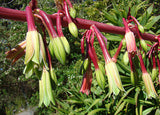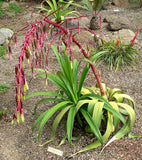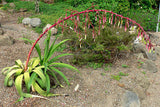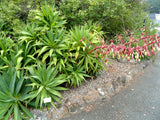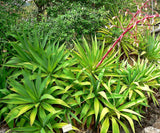“Mountain Phoenix” Beschorneria albiflora Seeds — Grow the Trunked Majesty of the Highlands
Awaken a legend of Mesoamerica in your own garden with this limited collection of Beschorneria albiflora seeds — a plant as enigmatic as it is architectural. With each seed sown, you invite centuries of botanical lore, pollinator intrigue, and leafy drama to your landscape.
🌿 Why This Plant Captivates
-
The only tree-forming Beschorneria — unlike its congeners that stay rosette-bound, B. albiflora gradually develops an above-ground trunk (sometimes 0.5 to 3 m or more) as it matures.
-
Its species epithet albiflora (“white-flowered”) alludes to its early floral tones — though its blooms evolve in hue over time.
-
Native to steep, mossy oak forests in Oaxaca, Chiapas, and parts of Guatemala and Honduras (often at altitudes around 2,000 m), it thrives on rocky slopes where water drains fast and soils remain aerated.
-
In Spanish vernacular, it is known by names such as “el falso maguey,” “ahuimo,” “cheche” or “quetzal beschorneria,” reflecting its folkloric standing among agave-like plants.
-
It is not monocarpic: unlike many agave relatives, the rosette persists or produces pups after flowering, so your lineage continues.
✿ Bloom & Wildlife Appeal
When your plant reaches maturity, it may send up a branching inflorescence in late winter to early spring. The flower stalks are vivid bright red, with pendulous tubular blossoms that emerge in tones of cream, pale green or white, gradually deepening to pink and red at the base as the flowers age.
These striking floral clusters are favorites of hummingbirds, who feed on their nectar and are frequent visitors.
While I found no firm records of specific butterfly or moth larvae using B. albiflora as a host plant, its nectar-bearing flowers may also attract long-tongued pollinating insects.
No strong documentation suggests a fragrance in cultivated specimens — if you encounter a faint scent, treat it as a bonus surprise rather than expectation.
❄ Hardiness, Size & Growing Notes
-
USDA Hardiness Zones: 8b through 10b (survives down to ~15–20 °F)
-
Mature Height & Spread: The rosette itself may span 3–4 ft wide; flowering stalks can tower 4–6 ft above the foliage. Over time, the forming trunk may carry the foliage several feet above ground.
-
Light: Prefers full sun to part shade. In very harsh sun, some midday shading is tolerated.
-
Soil & Drainage: Requires strongly well-draining, gritty or rocky substrates. Do not allow standing water.
-
Watering: Give moderate water in dry periods when young; once established it tolerates drought (with supplemental watering beneficial in full sun).
-
Protection: In colder climates near zone 8b or where frost is frequent, offer dry winter protection or grow in containers to move indoors.
✨ Why Your Garden Needs These Seeds
-
A living sculpture — the emergence of a trunk and soaring floral spikes turns your garden into a statement piece.
-
Pollinator magnet — hummingbirds will make your plant a favorite, weaving aerial dances to sip its nectar.
-
Rarity & fascination — this species remains uncommon in cultivation, offering both botanical prestige and conversation value.
-
Resilience — hardier than many tropical succulents, able to take moderate cold and drought once rooted.
-
Cultivation of heritage — by growing it, you plant a species rooted in the highland forests of Mexico and Central America, tapping into indigenous ecosystems and botanical tradition.
Let each seed release a whisper from the oak-moss slopes of the Sierra Madre. May your garden one day host a statuesque trunked Beschorneria, its red-flushed flower arms reaching skyward, visited by hummingbirds on cool dawns, and echoing the spirit of cloud-forest heights in your own soil.






